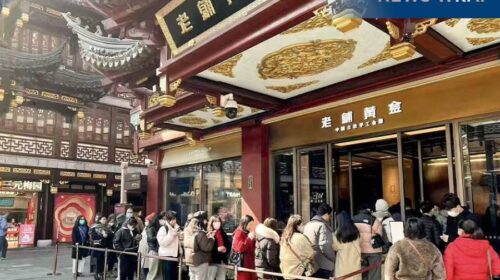Laopu Gold seeks IPO riches as its glittery margins raise questions

After two failed attempts to list in Shenzhen, the heritage gold seller has redirected its efforts towards the Hong Kong Stock Exchange
Key Takeaways:
- Laopu Gold earned 416 million yuan in profits last year, a 3.4-fold increase from 2022
- The heritage gold seller’s unusually high gross margins have attracted scrutiny from the Chinese securities regulator
By Lau Chi Hang
Gold prices have risen sharply these last two years amid ongoing geopolitical tensions, breaking the $2,000-per-ounce mark last year and climbing over 15% in the first few months of 2024 alone. The surge has prompted a new listing attempt by Laopu Gold Co. Ltd., which designs, produces and sells gold products.
Laopu markets its flashy goods as heritage gold items that combine contemporary design with time-honored craftsmanship. It says its matte and sandblasted finishes reflect the grandeur of ancient Chinese imperial courts. The company also points out it adheres to several of the China Gold Association’s traditional handcrafting standards, applying techniques including free forging, inlaying, enameling, hammering, chiseling, and filigree.
Contrary to its traditional-sounding name, Laopu, whose name means “Old Gold Shop,” is a relatively recent industry entrant, founded in 2009 by Xu Gaoming. In stark contrast to better-known names like Chow Tai Fook (1929.HK) and Chow Sang Sang(0116.HK) — which have been around for 95 and 90 years, respectively — Xu started Laopu by opening his first boutique specializing in traditional gold jewelry through his company Golden Treasury. The brand registered the Laopu Gold trademark in 2014 and was formally incorporated in 2016, transitioning the gold business along with associated assets and liabilities from Golden Treasury to the new entity.
By the close of 2023, Laopu had expanded its footprint to 32 boutiques across 13 cities in Mainland China, predominantly in first-tier urban centers, according to its listing document filed earlier this month. Each location averaged revenue of about 93.9 million yuan that year, effectively tripling its revenue year-over-year.
The company’s annual revenue climbed from 1.26 billion yuan in 2021 to 3.18 billion yuan last year, achieving compound annual growth of 58.6%. During the same period, its net profit similarly rose from 114 million yuan to 416 million yuan.
Shenzhen listing efforts fall short
Laopu attempted an A-share listing on the Shenzhen Stock Exchange in June 2020, only to have its application rejected a year later. The company then appointed China Securities as its new sponsor in 2022 and submitted another application in June 2023. But that also was withdrawn a month later.
After those setbacks on the A-share market, Laopu turned to Hong Kong, applying for an IPO on the city’s stock exchange last November, with final approval still pending. In an effort to bolster its public profile, the company opened a sizeable flagship store on Canton Road in Hong Kong’s Tsim Sha Tsui district, famous for its gold, jewelry and electronics stores, this April, timed to promote its listing ambitions.
Amid a thriving gold market and a growing interest in domestically inspired fashion and cultural products across Mainland China, gold jewelry made using traditional, time-honored techniques has surged in popularity. According to third-party data in the listing document, China’s market for heritage gold soared from 13 billion yuan in 2018 to 157.3 billion yuan in 2023, representing 64.6% in annual growth. The market is expected to expand further to 421.4 billion yuan by 2028, representing a slower but still impressive annual growth rate of 21.8%.
Outlier Profit Margin
Laopu capitalized on a robust market last year, nearly quadrupling its profits from the previous year. However, skepticism has emerged about such rapid improvement, especially in terms of its gross margins. The company recorded a gross profit margin of 41.2% in 2021 and 41.9% over the subsequent two years, starkly contrasting with Chow Tai Fook, which reported 24.9%, and others like Chow Sang Sang and Luk Fook (0590.HK), which posted margins of around 27%. The substantial discrepancy has led to market speculation on how Laopu manages such high margins compared to its competitors.
These concerns came into focus during Laopu’s initial attempt to list in Shenzhen when the China Securities Regulatory Commission (CSRC) pointed out that the company’s gross profit margins were unusually high. Laopu explained by attributing the lofty figures to its use of traditional crafting methods, which it claims enhances the craftsmanship and justifies higher prices and resulting higher margins.
Sharp Inventory Turnover Decline
Laopu has also significantly decreased its inventory turnover days, a change that has attracted attention as well. From 2021 to 2023, the figure fell sharply, from 357 days to 205. The latest number from last year is comparable to Luk Fook’s 190 days and much better than Chow Tai Fook’s 312 days. Logically, there doesn’t appear to be a problem.
Nevertheless, observers have raised questions about the sharp decrease in turnover days over the last year, as the figure fell from 383 days in 2022 to the latest 205 last year, suggesting the drop may owe to an accounting adjustment ahead of a potential listing. The speculation arises as turnover rates for Laopu’s peers have been more stable, making the company’s rapid improvement an anomaly. Laopu attributed the shift to the end of pandemic-related disruptions and an increase in sales last year, which collectively shortened the sales cycle.
Last year also saw Laopu’s inventory jump to 1.27 billion yuan, up 57% from 2022 and 64.5% from 2021. It’s quite possible that after reducing its inventory during the pandemic, Laopu built it up again last year to meet growing business needs as consumption returned to more normal patterns. However, despite this return to more normal business conditions, the company recorded a net cash outflow of 29.2 million yuan last year, in stark contrast to net inflows the two previous years. The company noted that increased inventory and trade receivables were significant factors.
Laopu’s substantial growth and strong performance last year were impressive, highlighting the company’s own potential as an investment. But the exceptional results have also prompted some cautious investors to wonder if the achievements are too good to be true, and whether in this case, all that glitters may not turn out to be gold.
To subscribe to Bamboo Works free weekly newsletter, click here






